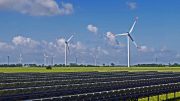Published October 16, 2020 Author Balkan Green Energy News
The European Commission has published a Renovation Wave Strategy aimed at improving the energy performance of buildings, in what is expected to cut emissions, increase the reuse and recycling of materials, boost post-COVID recovery, reduce energy poverty, and help the European Union (EU) achieve its goal to become climate-neutral by 2050.
The Renovation Wave Strategy aims to at least double renovation rates over the next ten years, seeking to ensure that 35 million buildings are renovated and up to 160,000 additional green jobs created in the construction sector by 2030, according to a press release from the commission.
In September, the European Parliament approved a report on maximizing the energy efficiency potential of the EU’s building stock, calling for a faster and deeper renovation of buildings and supporting the launch of an EU-wide rooftop solar program.
Only 1% of buildings in the EU undergo energy efficient renovation each year
Buildings account for about 40% of the EU’s energy consumption and 36% of greenhouse gas emissions from energy, while the annual rate of energy efficient renovation is a mere 1%.
Introducing tougher regulations and standards on energy performance
The strategy will prioritize action in three areas: decarbonization of heating and cooling; tackling energy poverty and worst-performing buildings; and renovation of public buildings such as schools, hospitals, and administrative buildings.
It envisages introducing stronger regulations and standards on the energy performance of buildings in order to set better incentives for public and private sector renovations; ensuring accessible and well-targeted funding; providing technical assistance to national and local authorities and training and skills development for workers in new green jobs; and expanding the market for sustainable construction products and services.
Buildings’ emissions must be cut by 60% to achieve the EU’s proposed 55% emissions reduction target for 2030
To achieve the emissions reduction target for 2030 of at least 55%, proposed by the European Commission in September 2020, the EU must cut buildings’ emissions by 60%, their energy consumption by 14%, and the energy consumption of heating and cooling by 18%, according to the press release.
The strategy also envisages a new European aesthetic for buildings
The strategy also envisages creating a “New European Bauhaus,” as announced by European Commission President Ursula von der Leyen, to nurture a new European aesthetic that will combine the affordable with the artistic and match sustainability with style, according to the press release.
Originally published by Balkan Green Energy News





